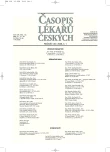Principle and Importance of Using the Array CGH in Hematooncology
Authors:
M. Jarošová; H. Pospíšilová; R. Plachý; M. Divoká; M. Holzerová; T. Papajík; J. Koptíková 1; K. Indrák
Authors‘ workplace:
Hemato-onkologická klinika LF a FN, Olomouc
; Centrum biostatistiky a analýz LF a PřF MU, Brno
1
Published in:
Čas. Lék. čes. 2006; 145: 9-13
Category:
Review Article
Overview
Identification of chromosomal changes and variation in DNA copy number allows us to understand pathogenesis of tumors. To the frequently diagnosed chromosomal changes belong acquired gains and losses of chromosomal regions carring genes involved in cellular proliferation and differentiation as well as oncogenes and tumor suppressor genes. The determination of gene changes is limited by techniques used for their identification. The introduction of genom-wide microarray technology, resolution has rapidly increased. Array comparative genomic hybridization (arrayCGH) offers higher resolution for genome-wide detection of chromosomal alteration and it is able to analyze hundreds to thousands of genes presented on microarray in one experiment. The aim of this study was to perform arrayCGH technology and to stress its value for the identification of chromosomal imbalances in hematological malignancies.
Key words:
DNA, in situ hybridization, CGH, arrayCGH, microarray, oncogene, tumor suppressor gene.
Labels
Addictology Allergology and clinical immunology Angiology Audiology Clinical biochemistry Dermatology & STDs Paediatric gastroenterology Paediatric surgery Paediatric cardiology Paediatric neurology Paediatric ENT Paediatric psychiatry Paediatric rheumatology Diabetology Pharmacy Vascular surgery Pain management Dental HygienistArticle was published in
Journal of Czech Physicians

Most read in this issue
- Impact Factor – Good Servant, but a Bad Master
- Acute Toxicity of High Dose Interstitial Brachytherapy Boost in Prostate Cancer
- Abuse of Buprenorphine Becomes a Problem of the Czech Republic
- Principle and Importance of Using the Array CGH in Hematooncology
